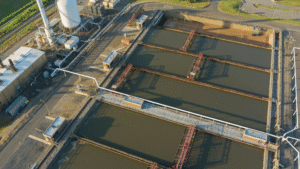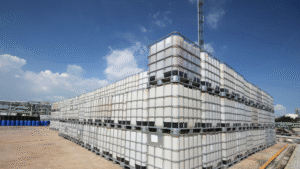Scale is one of the most persistent and costly challenges in industrial water systems. As minerals like calcium, magnesium, and iron accumulate on heat transfer surfaces, they create hard deposits that can slow operations, restrict flow, and lead to premature equipment failure. These issues affect everything from cooling towers to boilers, and even high-purity water treatment systems. Because scale forms gradually, many facilities do not recognize the severity of the problem until efficiency drops or components begin to fail.
Effective chemical treatment for water is the most reliable way to prevent scale before it becomes damaging. By using targeted water treatment chemicals, operators can stabilize hardness ions, control corrosion, manage contaminants, and maintain consistent water quality across the entire system. Modern water treatment approaches combine chemical control with mechanical filtration to keep equipment protected and running efficiently. Understanding how these treatments work is essential for protecting both equipment and operational budgets.
What Scale Is and Why It Forms in Water Systems
Scale forms when minerals naturally present in water, such as calcium, magnesium, and iron, separate from solution and attach to surfaces through a process known as precipitation. Most industrial facilities rely on groundwater sources, municipal supplies, or well water, all of which contain varying levels of mineral content and dissolved solids. When these minerals encounter heat, pressure changes, or shifts in pH, they become less soluble and begin forming hard deposits inside pipes, heat exchangers, and other components of a water system.
The most common types of scale, including calcium carbonate and magnesium silicate, form quickly in any environment where water is heated or recirculated. Hardness minerals are especially problematic in facilities that rely on high-temperature processes or equipment with metal surfaces that attract crystalline deposits. Even drinking water can contain minerals capable of forming scale under the right conditions, which is why residential appliances also experience buildup over time.
In industrial environments, the risk is far greater. As water cycles through cooling towers, boilers, and process units, changes in temperature and concentration make it easier for minerals to fall out of solution. Understanding these formation mechanisms is the first step in selecting the correct treatment strategy.
Also read: Smart Boiler Scale Control | ETI Water Treatment Solutions
How Scale Damages Industrial Equipment
Scale deposits create several compounding problems inside industrial water systems, and each issue increases operational stress on equipment. Understanding these factors helps facilities recognize why prevention is essential.
Reduced Heat Transfer Efficiency
Scale acts as an insulating layer on metal surfaces, especially in boilers, heat exchangers, and cooling towers. Even a thin layer of mineral buildup can dramatically lower thermal performance. When heat transfer drops, equipment must use more fuel or electricity to achieve the same output, which raises operational costs and accelerates system fatigue.
Increased Corrosion Risk
Scale frequently leads to corrosion, particularly under-deposit corrosion. Mineral layers block protective coatings and corrosion inhibitor films, which prevents them from reaching the underlying metal. Beneath the deposit, moisture and oxygen create microenvironments that can become highly corrosive, weakening system integrity. This type of localized attack progresses quickly and may compromise equipment far sooner than expected.
Flow Restriction and Mechanical Strain
As scale builds up, it reduces internal diameter inside the plumbing system and process piping. Restricted flow disrupts circulation patterns and forces pumps and valves to operate under increased strain. For facilities handling demanding industrial applications, poor flow performance directly impacts production capacity and can trigger unplanned shutdowns.
The Role of Chemical Treatment for Water in Preventing Scale
Preventing scale requires a treatment approach that manages minerals before they can form hard deposits. This is why chemical treatment for water remains the most effective strategy for industrial facilities. By relying on the right blend of water treatment chemicals, operators can stabilize hardness ions, control pH, inhibit crystal formation, and protect equipment surfaces throughout the entire treatment process.
Threshold Inhibitors and Scale Stabilizers
Threshold inhibitors increase the amount of mineral content that water can hold without forming deposits. These specific chemicals interfere with the early stages of crystal formation, allowing calcium and magnesium to remain dissolved even in high-temperature systems.
Crystal Growth Modifiers and Dispersants
Crystal modifiers alter the shape of mineral crystals so they cannot interlock into solid deposits. Dispersants keep particles separated by adding charge, making it easier to remove contaminants during blowdown or filtration.
pH Adjustment and Alkalinity Control
Maintaining proper pH adjustment is essential for preventing precipitation. Chemicals such as soda ash, sodium hydroxide, and zinc orthophosphate help adjust pH levels, stabilize water chemistry, and reduce corrosion on heat-transfer surfaces.
Ion Exchange and Hardness Management
Facilities that rely on ion exchange resins use this process to remove hardness ions entirely, replacing them with sodium ions. This is especially important in systems prone to scaling or where mineral control must be extremely precise.
Together, these chemical approaches form a preventive barrier against scale, ensuring long-term reliability and efficiency in industrial water treatment systems. When paired with good operational oversight, chemical programs are the foundation for keeping equipment protected and performance stable.
Learn more on: Understanding Condensate Treatment: Oxygen, CO₂, and the Role of Blended Amines
Supporting Technologies Used Alongside Chemical Treatment
While chemical programs form the backbone of scale prevention, mechanical and physical treatment methods play an important supporting role. These technologies help remove minerals, particles, and organic materials before they enter critical equipment, which improves system performance and reduces the overall chemical demand within a facility.
Water Softening and Hardness Reduction
A water softener uses ion exchange to remove calcium and magnesium, the primary minerals responsible for scale. By reducing hardness at the source, softeners lower the potential for mineral precipitation in downstream processes.
Reverse Osmosis and Filtration Systems
Reverse osmosis membranes remove a high percentage of dissolved salts, hardness ions, and harmful contaminants, producing low-mineral feedwater for sensitive operations. Mechanical filtration methods, including activated carbon filters, multimedia beds, and sand filtration units, eliminate suspended particles, organic matter, and odors that can interfere with chemical programs.
Coagulation and Pretreatment Steps
Processes like coagulation help cluster fine solids so they can be removed more easily. These steps reduce suspended solids, improve overall clarity, and make it easier to purify water before it reaches heat exchangers or boilers.
When used together, these mechanical tools and chemical treatments offer a balanced and reliable way to protect industrial systems from scale, fouling, and unwanted buildup.
Disinfection and Microbial Control Considerations
Scale does more than reduce mechanical efficiency. It can also create sheltered environments where bacteria, viruses, and other microorganisms thrive. Mineral deposits trap moisture and nutrients, making it difficult for disinfectants to penetrate and effectively control microbial growth. This is why scale management and disinfection must work together within a comprehensive water treatment strategy.
Common Disinfection Chemicals
Industrial facilities often rely on chlorine, chlorine dioxide, and sodium hypochlorite, each of which releases chlorine to disinfect water and support microbial control. Oxidizing agents like hydrogen peroxide can be used to disrupt biofilms, assist in killing bacteria, and reduce the risk of bacterial contamination in distribution loops.
Addressing Iron-Related Microorganisms
Some systems experience challenges from iron reducing bacteria, which accelerate corrosion and contribute to slime deposits. Effective disinfection is essential in preventing their growth and maintaining safe water conditions that support reliable industrial operation and, when appropriate, safe drinking water standards.
By managing both microbial activity and scale formation, facilities can prevent fouling, protect equipment, and maintain cleaner, more stable water systems.
ETI’s Approach to Chemical Treatment for Water
For nearly four decades, ETI has supported water treatment companies and industrial facilities with custom-blended solutions that enhance system reliability and long-term performance. Our expertise in chemical treatment for water allows operators, engineers, and service providers to manage scaling, corrosion, and contamination challenges across a wide range of industrial systems. ETI’s formulations are engineered for consistency, compatibility, and effectiveness inside water treatment plants, process loops, and heating systems that require stable, clear water and optimized equipment operation.
To address corrosion challenges in high-temperature environments, ETI provides advanced solutions such as our Rust Treatment for Boilers through Advanced Chemistry which protects treated water pathways, strengthens metal integrity, and helps reduce long-term operational costs.
For facilities facing scale accumulation, our Water Scale Remover offers rapid dissolution of mineral deposits and helps restore system efficiency while preventing recurring buildup.
ETI’s dedication to technical innovation, customer training, and collaborative service ensures that water treatment professionals across Pennsylvania and Ohio receive the chemistry support they need to maintain safe, efficient, and compliant water treatment programs.
Conclusion
Scale is one of the most damaging but preventable challenges in industrial water systems. With the right combination of chemical control, supporting technologies, and proactive monitoring, facilities can protect equipment, improve efficiency, and reduce long-term operating costs. Effective water treatment begins with understanding how scale forms and selecting the appropriate chemistry to keep systems clean and stable.
For guidance on preventing scale or selecting the right chemical solutions for your operation, contact ETI today. Our team is ready to help you protect your systems and maintain optimal water quality.
Frequently Asked Questions (FAQs)
What chemicals are commonly used to control rust and scale?
Facilities may use products such as ferric chloride, ozone, and specialized corrosion inhibitors. These chemicals assist in the removal of deposits, improve quality, and support long-term system health.
Does scale affect everyday applications like laundry or taste in drinking water?
Yes. Hard water minerals can reduce cleaning efficiency in laundry and may impact the taste of treated or softened water.
How do chemical treatments help protect the environment?
Modern formulations are designed for safe handling and reduced impact on the environment, improving system performance without excessive waste.
What factors influence the right treatment process?
Key considerations include metals, pH levels, mineral load, and system design. A quick view of system data helps determine the most effective approach.
Can chemical treatment assist with suspended solids and salts?
Yes. Chemical programs help manage fine particles, salts, and dissolved contaminants that interfere with water system performance.





